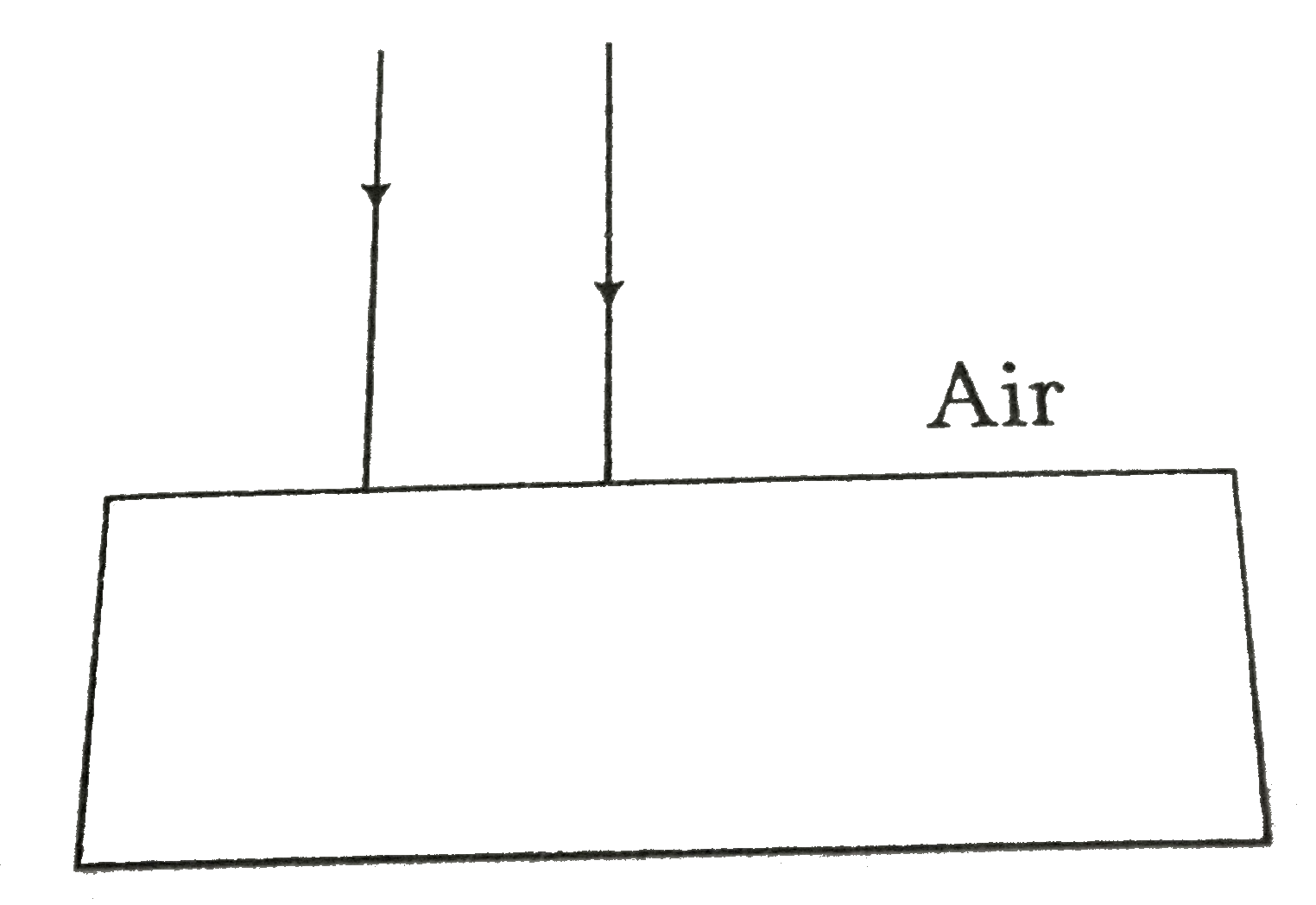A parallel beam of light of intensity I0 is incident on a coated glass plate . IF 25% of the incident light is reflected from the upper surface and 50 % of light if reflected from the glass plate , the ratio of maximum to minimum intensity in the interference region of the reflected light is
⎛⎜ ⎜⎝12+√3812−√38⎞⎟ ⎟⎠2
⎛⎜ ⎜⎝14+√3812−√38⎞⎟ ⎟⎠2
58
85
The correct Answer is:A
According to question , we can draw the following diagram
(##ARH5YSP17_E01014_S01.png width=80%><br> I_1=(I_0)/(4) implies I_2 = (3)/(8) I_0<br>Weknowtˆ,<br> (I_("max"))/(I_("min "))=((sqrt((I_1))+ sqrt(I_2))^2)/(( sqrt(I_1 )-sqrt(I_2))^2)=((1/2+sqrt(3/8))/( 1/2-sqrt(3/8)))^2
Topper's Solved these Questions
Similar Questions
A parallel beam of light of intensity I is incident on a glass plate. 25% of light is reflected in any reflection by upper surface and 50% of light is reflected by any reflection from lower surface. Rest is refracted The ratio of maximum to minimum intensity in interference region of reflected rays is

View SolutionA narrow monochromatic beam of light of intensity I is incident on a glass plate. Another identical glass plate is kept close to the first one and parallel to it. Each plate reflects 25% of the incident light and transmits the remaining. Calculate the ratio of minimum and maximum intensity in the interference pattern fromed by two beams obtained after reflection from each plate.
View Solution
Knowledge Check
A parallel beam of light of intensity I is incident on a glass plate. 25% of light is reflected in any reflection by upper surface and 50% of light is reflected by any reflection from lower surface. Rest is refracted The ratio of maximum to minimum intensity in interference region of reflected rays is
 A⎛⎜ ⎜⎝12+√3812−√38⎞⎟ ⎟⎠2B⎛⎜ ⎜⎝14+√3812−√38⎞⎟ ⎟⎠2C58DNone of these
A⎛⎜ ⎜⎝12+√3812−√38⎞⎟ ⎟⎠2B⎛⎜ ⎜⎝14+√3812−√38⎞⎟ ⎟⎠2C58DNone of theseLight of intensity 50W/m2 is incident on a arae of 1m2 in such a way that 25% of light is reflected back. Find the force exerted by light on surface if light incident perpendicularly
A10.8×10−8NB15.8×10−8NC20.8×10−8ND25.8×10−8N
_E01_107_Q01.png)
A narrow monochromatic beam of light of intensity I is incident on a galss plate as shown in figure. Another identical glass plate is kept close to the first one & parallel to it. Each glass plate reflects 25% of the light incident on it % transmits the remaining find the ratio of the minimum & the maximum intensities in the interference pattern formed by the two beams obtained after one reflection at each plate.
View Solution_E01_107_Q01.png)
A narrow monochromatic beam of light of intensity I is incident on a galss plate as shown in figure. Another identical glass plate is kept close to the first one & parallel to it. Each glass plate reflects 25% of the light incident on it % transmits the remaining find the ratio of the minimum & the maximum intensities in the interference pattern formed by the two beams obtained after one reflection at each plate.
View SolutionA narrow monochromatic beam of light of intensity 1 is incident on a glass plate as shown in figure Another identical glass plate is kept close to the first one and parallel to it. Each glass plate reflects 25% of the light incident on it and transmits intensities in the interference pattern formed by two beams obtained after one reflection at each plate.

View SolutionA narrow monochromatic beam of light of intensity 1 is incident on a glass plate as shown in figure Another identical glass plate is kept close to the first one and parallel to it. Each glass plate reflects 25% of the light incident on it and transmits intensities in the interference pattern formed by two beams obtained after one reflection at each plate.

View SolutionLight of intensity 50W/m2 is incident on a arae of 1m2 in such a way that 25% of light is reflected back. Find the force exerted by light on surface if light incident perpendicularly
View SolutionA parallel. beam of light of intensity I is incident normally on a plane surface A which absorbs 50% of the incident light. The reflected light fails on B which is perfect reflector. The light reflected by B is again partly reflected and partly absorbed and this process continues. For all absorption by .A, absorption coefficient is 0.5. The pressure experienced by A due to light is kIc. Find k.
'(##CEN_KSR_PHY_JEE_CO28_E01_028_Q03##)' (Here, c= speed of light ) FIGURE
View Solution
